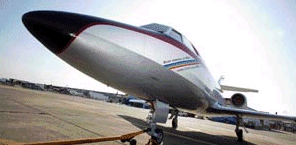Forty years after the appearance of the Falcon Mystére 20 heralded the birth of corporate aviation, the sector faces its most challenging times. The past two years have been painful: as corporate profits have slumped so orders and deliveries of business jets have nosedived - and there is worse to come.
But current difficulties should not deflect from a longer-term view of a fundamentally sound market, advises the latest Teal market report.
The 13th annual report, timed to coincide with the Paris airshow, concludes that the worst years of the forecast downturn are still better than any year before 1998.
It also claims that the business jet market is now worth more than the world combat aircraft market.
Richard Aboulafia, Teal's vice-president of analysis and the report's lead author, says: "After a meteoric ascent in the second half of the 1990s, this industry has stalled, and is rapidly losing altitude. Used aircraft prices have fallen and availability is way up. Clearly there has been some over investment both by fractional owners and the tech guys.
Extreme
"There are two extreme alternatives. Either the entire 1996-2000 period was a bubble, or we really are at a new high level, with 2003 merely being a momentary downturn.
"The likely truth is that between these extremes, with the market now in the midst of a profound downturn. This is the first down cycle of a transformed market.
"Beyond 2006 the market will resume its long-term growth although we do not see a return to the 2000-2001 peak until after our [10 year] forecast period.
"The fundamentals are in place for long-term growth."
The wide-ranging, warts-and-all report estimates production of 6,075 business jets worth $89 billion in the next 10 years. This compares with deliveries in the past 10 years of 5,006 aircraft, 40% of the estimated worldwide total of all business aircraft ever delivered which Teal estimates at 12,859.
Size will matter for the next decade, says the report - though Aboulafia suggests that Raytheon Aircraft's current difficulties mean it is potentially for sale and posits a new colossus with Dassault buying either Raytheon or Cessna.
Gulfstream will remain No 1 with a market share of 27.9%. Bombardier, needing to focus on profit, will see some loss of market share - to a projected 22.4%. Cessna will have 19.4% and Dassault 19.5%. Raytheon will be left with 9.4%.
"Big player dominance will continue as will the bias against new start-ups," says Aboulafia. "The big companies have the resources and critical mass to develop ever-important new models, and to withstand market downturns. And the aviation industry eschews new guys."
Factor
The role of fractional owners will continue to be a key factor in the success of the business jet industry. The relationship between fractionals and manufacturers is complex, the report stresses.
"Right now fractional companies account for 15-18% of new business jet deliveries. Their orders account for about 40% of the stated industry backlog." The difficulty for manufacturers is the clout the fractional operators have in the market.
"If a company buys one or two jets, the manufacturer will enforce the sales conditions and schedule, making deferrals difficult.
"But fractional companies, with their greater market power, will be able to demand deferrals - and possibly even cancellations - based on prevailing market conditions. The criticism of fractional firms is that their orders are less 'firm' than sales to traditional business jet end users."
The very model that has spurred the phenomenal growth in business aircraft sales in recent years may prove to be the downfall of one or more of the major players.

Source: Flight Daily News




















